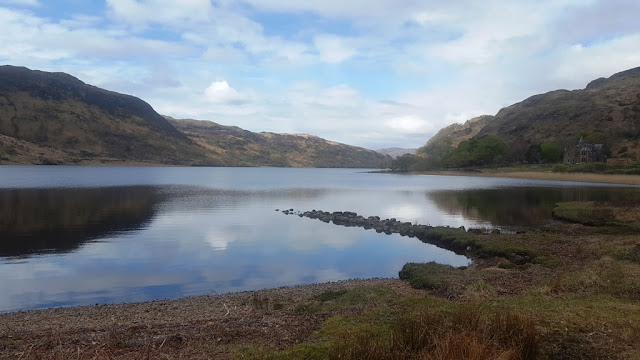North Mull Mesozoic Rocks - the Doirlinn
The Doirlinn (or Doirlinn a'Chailbhe) is the narrow channel between Mull and the Island of Calve, which is well seen from Tobermory. At the lowest of tides, it dries out and you can walk across from mainland Mull to Calve Island. Today at lunchtime was an opportunity to do just that.
As a tidal feature, the Doirlinn is interesting, but the geology also has something neat about it. It is one of only a handful of places in North Mull where the underlying Mesozoic rocks can be seen - Most of North Mull is covered in volcanic rocks, mainly plateau basalts of Paleogene age, cut by numerous minor intrusions (dykes and sills) However in a few places the older rocks on which the basalts have been deposited, the Mesozoic, can be see peeping out. The other places are north of the lighthouse at Rubha nan Gall, south of Tobermory near the Guala Dhubh and north of Tobermory at Bloody Bay, where the rock was once quarried.
I had a good look at this stuff today - below are some photos:
Hammer for scale. The rock is actually incredibly hard. Described in the Memoirt as a mudstone, it has been well indurated like a lot of these Mull Mesozoic rocks
EDIT: Here is the reference from Prof Judd:
I love the old fashioned style of language in these old texts. Had never heard of "Infralias" till I read this.
As a tidal feature, the Doirlinn is interesting, but the geology also has something neat about it. It is one of only a handful of places in North Mull where the underlying Mesozoic rocks can be seen - Most of North Mull is covered in volcanic rocks, mainly plateau basalts of Paleogene age, cut by numerous minor intrusions (dykes and sills) However in a few places the older rocks on which the basalts have been deposited, the Mesozoic, can be see peeping out. The other places are north of the lighthouse at Rubha nan Gall, south of Tobermory near the Guala Dhubh and north of Tobermory at Bloody Bay, where the rock was once quarried.
I had a good look at this stuff today - below are some photos:
Looking across the Doirlinn from the Mull side (near Aros Park) Low tide, and the way across is clear. Seaweed in the middle, sand to the left (the easiest way across)
Over on Calve looking back across the Doirlinn
On Calve, looking towards Tobermory. Basalt lava boulders. All of Calve is basalt with a few dykes
Another view towards Tobermory - Calve on the RHS, Aros Park on the LHS
The view from Calve down the Sound of Mull towards the hills above Craignure. Ben Talla on the right there.
Coming across the Doirlinn:
Looking south on the way back. Mainly sand underfoot. The pole is a navigation marker for boats
The rocks are strangely weathered - totally different from the basalt lavas in the weathering style:
Hammer for scale. The rock is actually incredibly hard. Described in the Memoirt as a mudstone, it has been well indurated like a lot of these Mull Mesozoic rocks
The distinctive jointing pattern to these rocks - very different in colour and jointing compared with the basalts.
A lump was duly extracted with some serious hammering. Picture here:
And here is a sample of it. According to the Memoir , "The Pre-Tertiary Geology of Mull Loch Aline and Oban" (Lee, Bailey et al, 1925) the description of the rocks at the Doirlinn is:
"In northern Mull, there are three exposures of rocks, which Mr G V Wilson agrees with Prof Judd, should probably be referred to the Trias. (Triassic) The most important occurs at the SE end of the strait separating Calve Island from Mull, where, according to Mr Wilson, nearly flat, cream and pink-coloured hard, calcareous muds contain bands of cream coloured cornstone" (E B Bailey)
The only other reference in the literature (that I can find anyway) is on the BGS map
where the rocks are indicated on the map as "Stw" (Stornoway Formation) which puts them at the very base of the Jurassic and possibly into the Triassic.
Anyway, its an interesting location, and well worth a visit. 40 minutes it took me to get there from the car park in Aros Park.So that's it for that location - I'll be looking at the other North Mull Mesozoic localities over the next few weeks.
I love the old fashioned style of language in these old texts. Had never heard of "Infralias" till I read this.













Comments